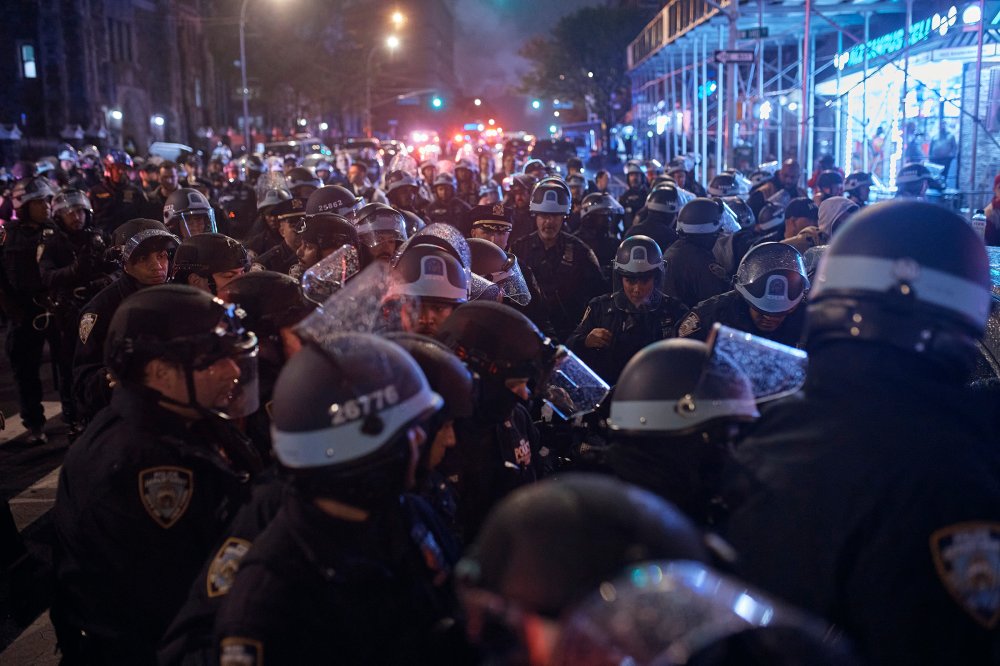









Police officers arrived on campuses at Columbia University and The City University of New York’s (CUNY) City College campus Wednesday evening, tasked by school administrators with restoring campus safety. However, their conduct is what made many students and protesters—who saw their large presence and actions as disproportionate and violent—feel unsafe.
Outside Columbia University’s Hamilton Hall on Tuesday night, police removed pro-Palestinian student protesters linked arms from each other. Most of them were women, according to TIME photographer Andres Kudacki, who says police threw chairs and trash cans. at least one protester hurtling down steps. As attending press, my eyewitness account, along with that of the protesters I spoke to, is detailed below.
Darializa Avila Chevalier, an Afro-Latina alumnus of Columbia University’s class of 2016 and former member of Students for Justice in Palestine, managed to stay on campus during the lockdown. She was among the women blocking the entrance to Hamilton Hall. They sang, “We shall not be moved,” amid the clanging of metal as police threw furniture, she tells TIME.
Police pushed her and others to the floor, Avila Chevalier says. “I felt totally helpless at that point… it was quite horrific,” she says. “There was nothing calm or organized about the situation.” Avila Chevalier says she has bruises on her legs and arms. Once arrested students arrived on the bus, they sang all the way to the police station to calm themselves down, she says.
When contacted by TIME, the NYPD did not comment on specific questions about restricting media access or violence towards students, but sent a link to a press conference held by the city on Wednesday. At that event, New York City Mayor Eric Adams said there “were no injuries or violent clashes” and described the policing operation as “organized” and “calm.” He went on to blame “external actors hijacking a peaceful protest and influencing students to escalate” without elaborating on how many of the arrested were not students.
Columbia directed TIME to university addressed to members of the Columbia community, which was sent on Wednesday. She acknowledged inviting the NYPD onto campus and thanked them “for their incredible professionalism.”
“Students and outside activists breaking Hamilton Hall doors, mistreating our public safety officers and maintenance staff, and damaging property are acts of destruction, not political speech,” she wrote. Shafik did not expand specifically on how public safety officers and maintenance had been treated.
The NYPD arrested “approximately 300 people” at Columbia and City College campuses, per Mayor Eric Adams. Charges include trespassing, criminal mischief, and burglary. Student protesters at Columbia University had occupied Hamilton Hall just after midnight on Tuesday, following a breakdown in negotiations with the administration over divestment and amnesty for disciplined students. They renamed the building “Hind’s Hall” as a tribute to 6-year-old , who was killed during Israel’s military offensive in Gaza. on Wednesday shows the encampment has been cleared. The encampment at City College .
Ahead of approaching the students, police ordered press to leave the Hamilton Hall area, TIME photographer Kudacki recalls. He managed to stay right outside the building, although says that police pushed him and threatened him with arrest. “Get out of here,” they told him, as they carried students away, holding them by their arms and legs.
Police barred press from entering Hamilton Hall, where they pursued students who were occupying the academic building. Desperate for any information, the public tuned into WKCR—Columbia University’s radio station—where student journalists could be heard talking about descending onto campus. The student journalists asked police where they should go and worried that no one would be left to document the raid. “… and he said, ‘If you come out one more time then you’re going to get arrested,’” one reporter said on air. “After what I saw today, I don’t know how I can feel safe on this campus with this police presence,” a .
Samaa Khullar, a journalist reporting on Columbia’s campus protests and a student at the university’s journalism school, said that “.” She said student press were from Hamilton Hall. “It’s hard to take this as anything but the administration trying to prevent recordings/photographs of brutal arrests,” she (formerly Twitter).
Police locked down campus and some of the surrounding area, leaving many protesters stuck a few blocks down the road. Every time a bus full of arrested students approached, protesters cheered. Police constantly pushed them back. One protester told a cop: “You’re on the wrong side of history, you’ll see in 20 years.”
Three female Columbia undergraduate students, who are supportive of pro-Palestinian protests and the divestment demands, stood at the police barricade, wondering who officers were protecting. “To police our students in this manner is disgusting” and displays a “flagrant disregard for our wellbeing,” one of them tells TIME. They asked for anonymity because they feared discipline from the school’s administrators. The students say that antisemitism allegations have been weaponized to crack down on pro-Palestinian protests. “It makes it easier because if you can weaponize that then you have grounds to treat these students the way that they do… it looks like [Columbia University’s President Minouche Shafik] is protecting someone when she’s calling the police on her students,” one of the students said. They stress that Shafik’s position was created to serve them and not politicians. It’s not too late to divest or extend amnesty to disciplined students, they say.
Police also arrived on and around CUNY’s City College campus, where they held back peaceful protesters, who were chanting slogans, by rushing at them with batons. “There is no violence here, why are you in riot gear?” protestors chanted.
CUNY noted in a Wednesday that “Tuesday night’s actions were taken in